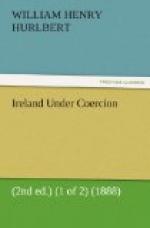The National Gallery in London has loaned some pictures to Dublin, and Mr. Doyle is getting together, from private owners, a most interesting gallery of portraits of men and women famous in connection with Irish history. The beautiful Gunnings of the last century, the not less beautiful and much more brilliant Sheridans of our own, Burke, Grattan, Tom Moore, Wellington, Curran, Lord Edward Fitzgerald, O’Connell, Peg Woffington, Canning, and Castlereagh, Dean Swift, Laurence Sterne are all here—wits and statesmen, soldiers and belles, rebels and royalists, orators and poets. Two things strike one in this gallery of the “glories of Ireland.” The great majority of the faces are of the Anglo-Irish or Scoto-Irish type; and the collection owes its existence to an accomplished public officer, who bears an Irish name, who is a devout Catholic, and who is also an outspoken opponent of the Home Rule contention as now carried on.
The gallery is open on liberal conditions to students. Mr. Doyle tells me that a young sister of Mr. Parnell was at one time an assiduous student here. He used to stop and chat with her about her work as he passed through the gallery. One day he met her coming out. “Mr. Doyle,” she said, “are you a Home Ruler?” “Certainly not,” he replied good-naturedly. Whereupon, with an air of melancholy resignation, the young lady said, “Then we can never more be friends!” and therewith flitted forth.
A small room contains some admirable bits of the work of Richard Doyle, among other things a weird and grotesque, but charming cartoon of an elfish procession passing through a quaint and picturesque mediaeval city. It is a conte fantastique in colour—a marvel of affluent fancy and masterly skill.
I found here this morning letters calling me over to Paris for a short time, and one also from Mr. Davitt, in London, explaining that my note to him through the National League had never reached him, and that he had gone to London on his woollen business. I have written asking him to meet me to-morrow in London, and I shall cross over to-night.
LONDON, Wednesday, Feb. 15th.—Mr. Davitt spent an hour with me to-day, and we had a most interesting conversation. His mind is just now full of the woollen enterprise he is managing, which promises, he thinks, in spite of our tariff, to open the American markets to the excellent woollen goods of Ireland. He has gone into it with all his usual earnestness and ability. This is not a matter of politics with him, but of patriotism and of business. He tells me he has already secured very large orders from the United States. I hope he is not surprised, as I certainly am not, to find that the Parliamentarian Irish party give but a half-hearted and lukewarm support to such enterprises as this. Perhaps he has forgotten, as I have not, the efforts which a certain member of that party made in 1886 to persuade an Irish gentleman from St. Louis, who had brought over a considerable sum of money for the relief of the distress in North-Western Ireland, into turning it over to the League, on the express ground that the more the people were made to feel the pinch of the existing order of things, the better it would be for the revolutionary movement.




